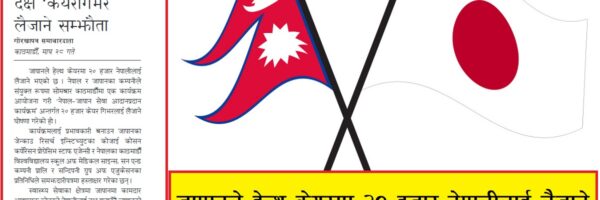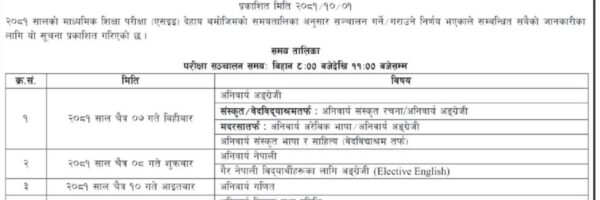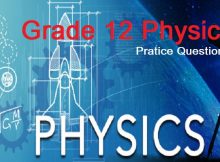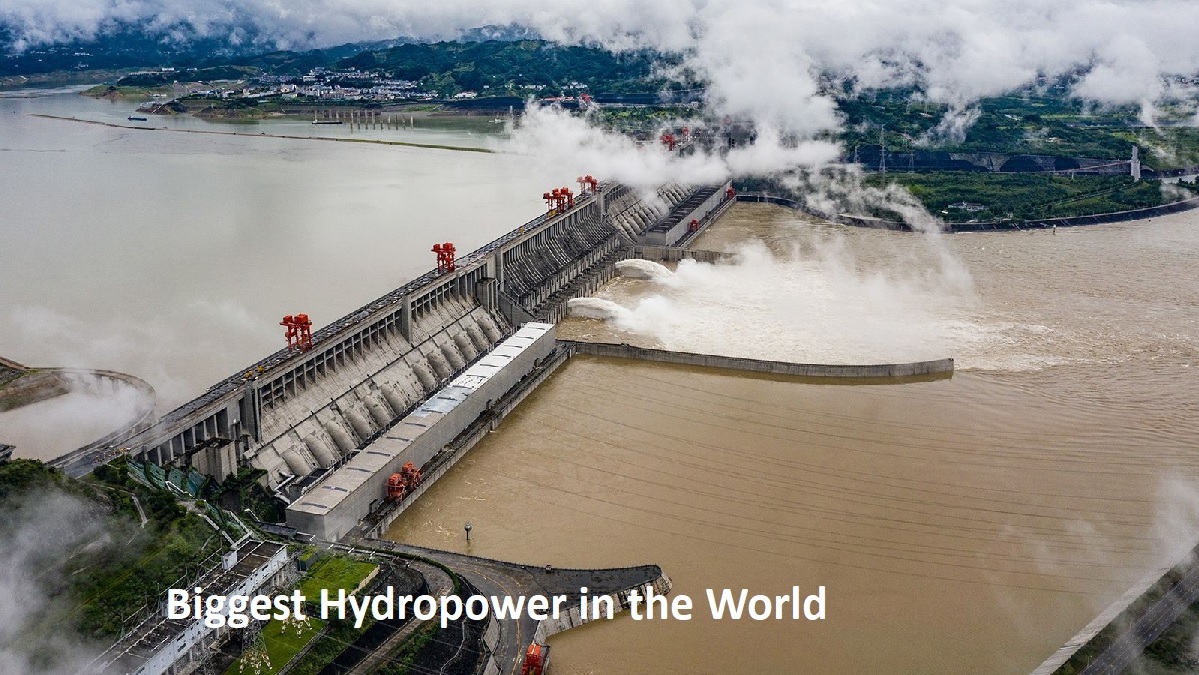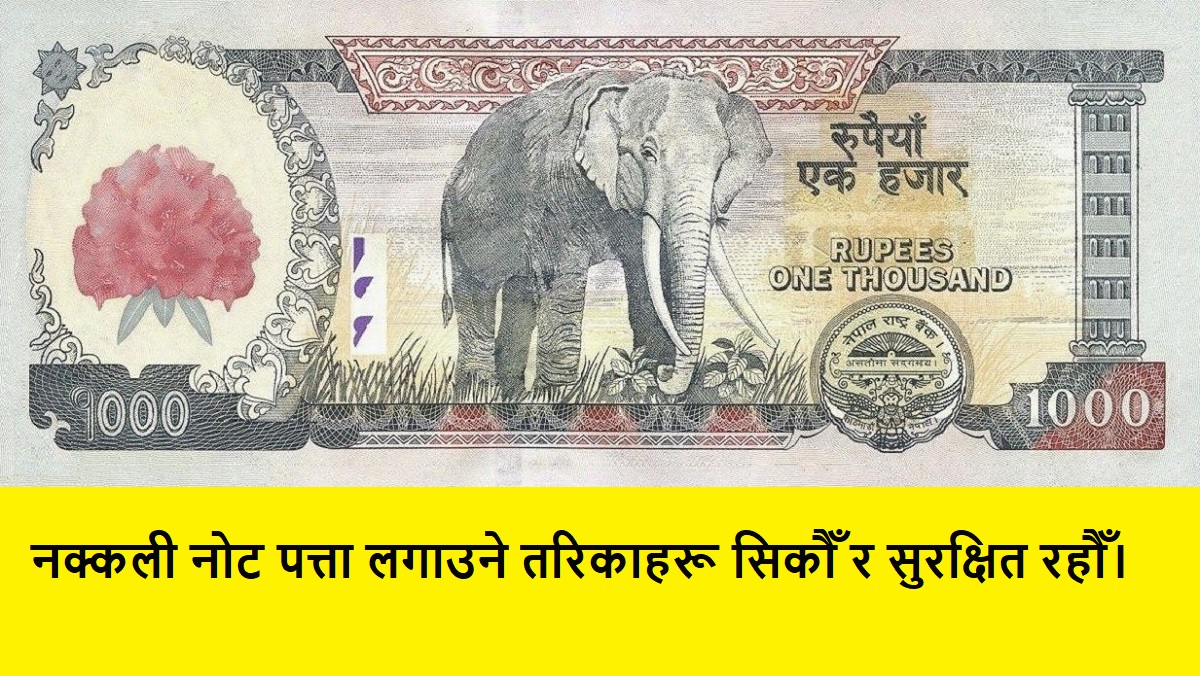Here are Grade 12 Physics practice questions. Students fell little tough in this subject. So this practice material will help a lot for grade 12 physics students.
These questions are based on HSEB board exam pattern.
Set I
Group ‘A’
- Attempt any four questions. 2×4=8
- A current carrying wire does not get charged. Comment.
- Why is potentiometer preferred over voltmeter measuring voltage?
- What is the use of cylindrical soft iron in moving coil galvanometer?
- If a metal rod falls vertically, will emf induce across its end?
- A wire is divided in to two equal parts along its length. What happens its resistivity.
- Why is the conductivity of electrolyte low as compared do that of metal?
Attempt any four questions. 2×4=8
Table of Contents
- Why not electric discharge takes place at high pressure?
- Make a truth table for two inputs AND gate.
- How does value of work function influence the kinetic energy of electron liberated by photoelectric emission?
- A patient is suggested to put off gold ornaments before entering into the x-ray room. Explain why.
- How is an particle emitted from radioactive nucleus?
- What are quarks? What is quark combination of neutron?
- Attempt any one questions. 1×2=2
- Why are bells made of metals and not wood?
- What is meant by pressure implitude?
Attempt any one questions. 1×2=2
- Two independent monochromatic points sources cannot produce sustained interference. Explain.
- Why are radio waves used for radio broadcasting?
Group: ‘B’
Attempt any three questions.
- Find torque on a rectangular coil in a magnetic field.
- Write the differences between Diamagnetic, Paramagnetic & ferromagnetic substances.
- What is Amperes circuital law? Use this law to determine magnetic field at the centre of circular coil.
- What is seebeck effect? How does emf of a thermocouple vary with temperature of hot junction?
Attempt any three questions. 4×3=12
- How is P-N junction diode used for full wave rectification?
- Describe construction and working of He-Ne laser.
- Discuss Einstein photoelectric equation. Establish the relation between work function and threshold frequency.
- Give a brief account on ‘Fuel and the pollution’.
Attempt any one questions. 1×4=4
- How did Laplace correct Newton’s formula for velocity of sound in gases? Does it agree with the experimental result?
- What is Doppler’s effect? Derive the change in frequency when an absorber moves towards a stationary source.
Attempt any one questions. 1×4=4
- What is wavelet? On the basis of wave theory, verify the law of reflection of light.
- State and prove Brewster’s law.
Group: ‘C’
Attempt any two questions. 2×4=8
- A galvanometer of resistance 75can measure a current up to 5MA. How can it be converted to an ammeter reading up to 3A?
- A uniform rod of length 25m falls vertically with its ends pointing east-west direction. Find emf induced across its end. (Given angle of dip 540 & resultant intensity of earth magnetic field 410-4
- A circuit consists of a capacitor of a capacitor of 2F and a resister of 10000. An alternating emf of 12V(rms) and frequency 50Hz is applied. Find (i) The current flowing (ii) The voltage across the capacitor (iii) Phase angle between applied emf & current.
Attempt any two questions. 2×4=8
- a. Electrons which have been accelerated by a potential difference of 1000volt enter co-terminus electric and magnetic field of strength 20V cm-1 and 10-4T respectively as in Thomson’s experiment. Estimate e/m and speed of electro if they move undeviated through the system.
- b.If 1g radium emits 3.71010 particles/ sec. Find the half life and average life of radium. Given atomic weight of radium=226, Avogadro Number N=6.0251023/g-mole.
- c.The ground state of the electron in the hydrogen atom may be represented by the energy -13.6ev and first two excited state by -3.4ev and -1.5ev respectively. Use this data to calculate the ionization potential of the hydrogen atom and the wavelength of first line in the emission spectrum of hydrogen. Charge of the electron=-1.610-19c
Speed of light in vacuum=3108ms-1
Planks constant = 6.610-34Js
- A wire stretched between two rigid supports vibrates in its fundamental mode with a frequency of 45Hz. The mass of the wire 3.510-2kg and its linear density is 410-2 kgm-1. What is (i) speed of transverse wave on the string? (ii) tension in the string?
- In a young’s double slit experiment the separation of forth fringe is 2.5mm when wavelength used is 6.210-7m. The distance from the slits to the screen is 0.8m. Calculate separation of the two slits.
Set II
Group: ‘A’
- Attempt any four (4×2=8)
- The element of heater is very hot while the wire carrying current are cold, why?
- What do you understand by Faraday? What is its value?
- Why is the cylindrical core of soft iron used in moving coil galvanometer?
- Why the hall voltage is much more measurable in semiconductors than in metals?
- The vertical and horizontal components of the earth’s magnetic field at a place are equal. What is the value of dip at that place?
- Why can’t a transformer be used to change the value of dc voltage?
Attempt any four questions. (4×2=8)
- Why is light produced during electric discharge in gases?
- What is meant by stimulated emission?
- Write quark combination of proton and antineutron.
- How is volume of nucleus related to mass number?
- What do you mean by curie?
- Write truth table for two inputs (NOR) gate.
Attempt any one question. (1×2=2)
a.Solids can propagate both longitudinal and transverse waves but liquid and gas can propagate only longitudinal waves why?
b.How is it that one can recognize a friend from his voice without seeing him?
Attempt any one question. (1×2=2)
- How can we verify that light coming from the sky is partially polarized?
- Does the phenomenon of interference obey the law of conservation of energy? Explain.
Group: ‘B’
Attempt any three questions. (4×3=12)
- State Kirchhoff’s laws of electric network and apply it to find the balanced condition for a Wheatstone bridge.
- Using Biot-Savart law, derive an expression for the magnetic field at a point on the axis due to an infinite long current carrying solenoid.
- Obtain an expression for the emf Induced in the conductor moving in a magnetic field.
- An alternating emf is applied across a capacitor show that the current in it leads to the applied emf by 900.
Attempt any three questions. (4×3=12)
- State and explain uncertainty principle.
- What is rectification? How do two diodes work as full wave rectifier?
- Derive Bragg’s equation and explain how is this equation used to determine the crystal plane spacing?
- Discuss the energy crisis in Nepal.
- Attempt any one question. (1×4=4)
- Describe Newton’s expression for the velocity of sound in a gas with Lap-lace correction.
- Prove that both types of harmonics, odd and even, can be produced in an organ pipe open at both ends.
Attempt any one question. (1×4=4)
- Describe Young’s double slits experiment for the interference of light and show that width of bright and dark fringes are the same.
- State Huygen’s principle. Use the principle to verify the laws of refraction of light on the basis of wave theory.
Attempt any two questions. (2×4=8)
- The driver cell of a potentiometer has an emf of 2v and negligible internal resistance. The potentiometer wire has a resistance of 3. Calculate the resistance needed in series with the wire if a p.d. of 5 mv is required across the whole wire.
- A copper wire 14m long is wound into a flat circular coil 4cm in diameter. If an electric current of 9A flows through the coil, what is the flux density at the centre of the coil?
- An iron cored coil of 2H and 50 resistance is placed in series with a resistor of 950 and a 220v, 50Hz ac supply is connected across the arrangement. Find (i) the current flowing in the circuit and (ii) the voltage across the coil.ra
Grade 12 Physics Group C Questions
Attempt any two questions. (2×4=8)
- The photoelectric work function of potassium is 2ev and the surface is illuminated with radiation of wavelength 350nm. What potential difference has to be applied between potassium surface and the collecting electrode in order just to prevent collection of electrons?
What would be the kinetic energy of the electrons?
- In an experiment a single charged drop was found to fall under gravity at a constant terminal velocity of 0.004 cm per sec. and to rise at 0.012 cm per sec when field of V/m was suitably applied. Calculate electronic charge given that the radius r of the drop was m and the coefficient of viscosity ” of the gas under condition of experiment was .
- The unstable isotope of potassium-40 has half life of years. How many decays occur per second in a sample containing g of potassium-40?
- Two observers A and B are provided with source of sound of frequency 500Hz. A remains stationary and B moves away from him at a velocity of. How many beats per second are observed by B, the velocity of sound in air being? (4)
- How wide is the central diffraction peak on a screen 3.5m behind a 0.010mm slit illuminated by 500nm light? (3)
